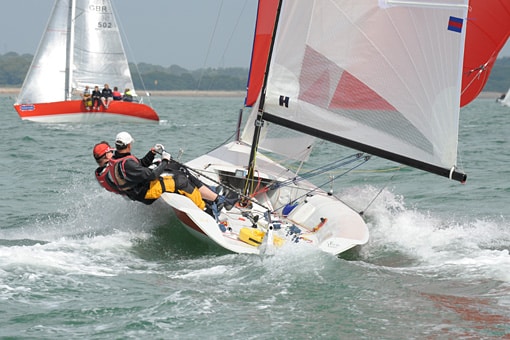
The Viper 640 satisfied our judging panel on all counts. Above all, said Carl Schumacher, “it’s a sweet sailing boat.
The panelists agreed that the Viper is inherently simple, offers quality construction at a great price, and is extremely fun to sail. An attractive looking boat, the Viper invites a wide range of sailors to an equally wide range of sailing.
“I think the Viper is a really neat boat, and I see a lot of reasons for its existence,” said multihull designer Peter Wormwood. “I also see a lot of reasons for it to grow as a strong one-design. It definitely is a step up to the future for one-design sailors.”
“The Viper is the boat that I felt most comfortable with, and I stand behind my decision because it’s a damn good boat,” added Schumacher. “I’m an old conservative from Orange County [Calif.]; and if [the Viper] takes off, it will be neat one-design sailing. Even at my age [47], I could see sailing the Viper for at least another 10 years.
We tested the boat in 10 to 15 knots of breeze, and it charged through the Chesapeake Bay chop without hesitation. The helm was very responsive and light through tacks and jibes, and remained neutral as the breeze came up. As the boat accelerated away from the wind, under the power of a 425-square-foot asymmetric kite, the boat quickly popped onto a plane, always with the feeling of being in control.
“The bow was always knuckle up,” noted judge Scott Ferguson. “It required little or no crew weight adjustment fore and aft.”
Designer Brian Bennett shaped the hull to create a quick-planing and responsive keelboat with a big-dinghy feel. At 21 feet LOA, its sharp, nearly plumb bow and strong sailplan enabled it to power upwind easily. The beam measures 8 feet, offering great stability. This, combined with a 185-pound bulb keel, kept the boat from capsizing, no matter how hard we tried.
The Viper had many positive attributes, but we were especially impressed with the efficiency of its systems. A common snafu of small performance boats is the cockpit clutter and line snarls that can develop. On the Viper, all controls lead where they need to go, creating a cockpit layout that is clean, simple and efficient. Sail controls are easy to adjust, even under load, which allows the crew to get their heads out of the boat and into the tactics at hand. The boat is intended for a crew of three or four; class rules allow a maximum crew weight of 540 pounds, so crew selection should be easy. The judging panel agreed that it won’t require a team of big, strong and nimble athletes to race and enjoy the boat.
Everyone has a line to pull: the helmsman tends the mid-boom, bridled mainsheet; the vang and jib halyard controls are led to the middle crew; and the main cunningham, 2:1 jib sheets and pole controls are led to the forward crew. Harken and Ronstan hardware are nicely recessed into the rounded tanks for comfortable hiking and bite-free sailing.
Of the 19 boats we tested, the Viper’s spinnaker launch-and-retrieval system worked best. The retractor system keeps lines from getting tangled, and a roller at the aft edge of the launching well reduces friction on the hoists and douses. The kite went up and down with astounding ease.
Bennett introduced the prototype two years ago and has successfully worked through the teething pains to produce a great boat. The systems are much refined, and some earlier rig problems are reportedly fixed. Bennett’s reputable service record and energetic support of the class as it developed last summer are encouraging.
The most impressive credential for the Viper is its win in the Performance One-Design category, which was the tightest race in the contest. The Viper was stacked up against the 49er, which the panel felt was “an athletic boat, not for the weary,” the Blaze “an incredibly fun boat to sail,” and the MX-Ray, another “physical boat.” All were extremely fun to sail as well, and the Viper’s success was not assured until the panel agreed that the winner should be fun and challenging to sail while presenting a good value. We also felt that it should serve the sport by appealing to a wide range of sailors. In addition, it had to be easy to rig and launch and offer good one-design racing potential. The Viper 640 was our unanimous choice for all of these reasons.
The class rules maintain strict, low-cost one-design racing. With durability in mind, the 165 square-foot mainsail material is limited to Dacron. The 87 square-foot, non-overlapping, hanked jib is polyester-reinforced Mylar. To further keep costs down, Bennett opted for a Proctor aluminum mast.
At a price of [$16,750] with sails, trailer and compass, the Viper offers a lot of boat for the money. It is solid, nicely detailed and well constructed (vacuum bagged epoxy/Divynicell foam with quadraxial cloth). The carbon lifting keel, carbon rudder and bow pole contribute to an astounding all-up weight of 700 pounds. This makes the boat easy to ramp or hoist launch and trailerable behind a small car. In addition, it is easily rigged from trailer to sailing in less than an hour.
Bennett and his crew at Viper Boats invested quality time developing this boat to make the Viper 640 fast, fun and widely appealing. As the Overall Boat of the Year and top Performance One-Design, the Viper 640 is without a doubt, “a sweet sailing boat.”
Specifications
LOA: 21’1″
LWL: 19’1″
BEAM: 8’2″
DSPL: 725 lbs.
BALLAST: 185 lb.
DRAFT: up 1’10, down 4’6″
SA: 252 sq. ft.
DESIGNER: Brian Bennett
CONTACT/PHONE: Viper Boats, 590 Fish Rd., Tiverton, RI 02878, 401/625-5290, toll-free: 888/viperfun
PRICING: $16,750
— Betsy Alison, sailmaker for North Sails, R.I., and four-time Rolex Yachtswoman of the Year, was a rookie BOTY panelist. As such, she earned the responsibility for all capsize testing.








